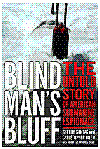
by Sherry Sontag and Christopher Drew, Public Affairs, 1998, 321 pp, $25.00
Everyone I know is reading this book. It's a fascinating topic: U.S submarine intelligence missions during the Cold War. These include infamous intelligence programs like Project Jennifer, the attempt to recover a sunken Golf submarine; Ivy Bells, the tapping of Soviet submarine cables near Russian Navy bases, and trailing Soviet submarines, especially their ballistic missile subs. They also discuss the losses of Thresher and Scorpion and how they affected the intelligence program.
The chapter on Scorpion is the best examination of the incident ever made. Project Jennifer is fairly well known now, a CIA program to recover intact a sunken Golf-class ballistic-missile submarine. What is not so well known was the cost of the project and the controversy within the intelligence community about the program, and the political considerations that may have affected it.
Ivy Bells is a much less well-known, and far more successful program, although at great risk. US submarines located and tapped phone lines that ran between the naval bases in the sea of Ohkosk and the Barents seas. These supposedly secure cables carried uncoded or lightly coded fleet communications, including readiness reports, intelligence reports, operational orders, and a wealth of other data. The taps were established by divers leaving the sub and working on the sea bed under extremely dangerous conditions. Once established, submarines regularly visited the tap site to gather information collected by a purpose-built pod left at the site. Subs who successfully accomplished one of these operations routinely received a Presidential Unit Citation at the end of each mission.
The authors have done their homework. An excellent Notes section at the end describes how they obtained the material for each chapter, including many standard reference books, government documents obtained through the Freedom of Information Act, and many personal accounts. Some of this material has been published in news accounts before, but this is the most complete accounting ever made.
With their background as reporters, I was expecting a certain breathless tone as these secret projects were described. Thankfully, the material itself is exciting enough, and the authors respect the officers and men who struggled and improvised to accomplish these missions. They do ask hard questions about the legality of operations inside Soviet territorial waters, and about the terrible risks submariners were expected to make, unasked, in what was supposed to be peacetime.
A fascinating bonus is a collection of known Soviet submarine accidents, incidents, and collisions. These are genuinely scary. One Soviet Echo-class sub was nicknamed Hiroshima because she'd killed so many men in three separate reactor accidents. There are also several accounts of tremendous bravery. There's nothing else like this book on the market. We're lucky it's such a good one.
BT
Back to The Naval Sitrep #16 Table of Contents
Back to Naval Sitrep List of Issues
Back to MagWeb Master Magazine List
© Copyright 1999 by Larry Bond and Clash of Arms.
This article appears in MagWeb (Magazine Web) on the Internet World Wide Web.
Other military history articles and gaming articles are available at http://www.magweb.com